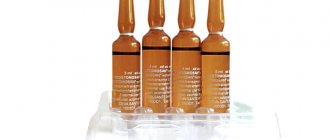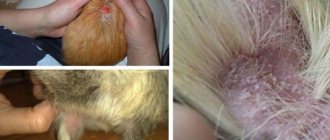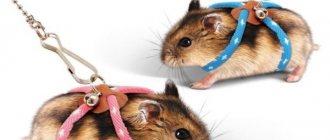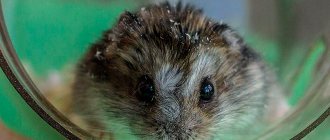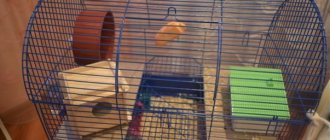To paraphrase the famous saying, we can say that the person who tamed the animal is responsible for its future fate. First of all, a small hamster is not a funny “toy”, but a living creature with its own “problems”. The animal can get sick and become infected with parasites. The owner will have to save the pet.
The health of the rodent depends on the correctness of his actions and the chosen methods of treatment. Negligent behavior can result in the death of a pet or unpleasant consequences for a person.
Can a hamster have fleas?
You need to look for an answer to the question of whether hamsters have fleas before the animal gets into the house. The decision to have a pet should be a conscious one, so you should initially become familiar with the peculiarities of keeping animals in the house and possible diseases of the rodent. Yes, hamsters have fleas!
The animal's body is covered with fur, and the skin is easily bitten by parasites. Contrary to popular belief, fleas do not live directly on the body of animals, but regularly feed there. It makes no difference to parasites whose blood they drink - cats, dogs, mice or hamsters. The most susceptible to pest attacks are fluffy Syrian, royal, and Angora hamsters. Animals of the Dzungarian and Roborovsky breeds suffer less from this scourge.
Djungarian hamster
Eye diseases
Due to their physiological characteristics, Syrian and Djungarian hamsters (as well as representatives of other species) often suffer from ophthalmological pathologies. One of the most common diseases is conjunctivitis (allergic, serous, purulent). Animals are also susceptible to cataracts, glaucoma, and uveitis (inflammation of the choroid).
You can tell if your hamster is sick by the following signs:
- spasmodic closing of the eyelids (spasm of the orbicularis oculi muscle);
- increased lacrimation;
- swelling;
- redness of the eyes;
- mucous or purulent discharge;
- sticking of eyelids.
If such symptoms appear, you should contact your doctor.
It is important to identify the causative agent of the disease (viruses or bacteria) and select appropriate drugs. Usually eye diseases in hamsters are treated with drops or ointments.
Bacteriostatic solutions (Sulfacetamide, Sofradex) and Tetracycline ointment are often used for this purpose.
In advanced cases, the veterinarian will prescribe an antibiotic for the hamster. And vitamin preparations help boost immunity, speed up recovery, and prevent relapse of eye disease. In the initial stages, you can use chamomile decoction or Furacilin solution.
In the absence of timely treatment, the risk of developing a purulent process, visual impairment or complete blindness increases.
Tumors, boils and abscesses
Often, ulcers and neoplasms of a benign or malignant nature are detected in rodents. These could be bumps on the body or a growth in the ear. Pathological formations may appear if the hamster fell from a height, was injured during a fight with relatives, or was attacked by other animals.
To understand the cause of the tumor, you need to show your pet to a veterinarian.
An abscess in a hamster can form from a regular scratch or small wound. After infection penetrates, pus accumulates in the affected area (under the skin). The abscess looks like a swelling that causes pain when pressed. An abscess can form due to prolonged inflammation of the cheek pouches. The disease is treated surgically.
Often, rodent owners worry about why their hamster has large testicles. More often this phenomenon is normal and indicates readiness for reproduction. But sometimes enlargement of the genital organs is associated with illness:
- the eggs became swollen and their size became more than ¼ of the animal’s body;
- testicles interfere with walking;
- the animal is lethargic, eats poorly, passive;
- the testicles turned red and became hot to the touch;
- the hair on the genitals has completely fallen out;
- hamster tries to gnaw testicles.
If such symptoms appear, you should immediately take your pet to the doctor. Especially if the appearance of alarming signs was preceded by a fall, severe bruise or other injury.
Oncological formations are treated surgically. The sooner the surgery is performed, the greater the chance of a full recovery. If metastases appear, the pet will have to be euthanized. The same should be done if the tumor is localized in a hard-to-reach place, for example in the mouth.
Routes of infection
Fleas on a hamster are not a natural phenomenon. This animal is not their permanent “master”. However, under certain conditions, they can exhaust the animal for a long time.
Main sources of infection:
- Other pets and pests. Cats, dogs, as well as rats and mice bring insects into the house. Infection occurs during mating if one of the participants in the process is a temporary guest.
- Stay at the pet store. There are situations when a pet is brought into the house already infected. Initially, the symptoms are not visible, but appear over time.
- Street grass. Rodents are offered green grass that grows outside as food. The eggs and the insects themselves are found in sand, soil and thickets. Thus, the person himself brings the infection into the house.
The likelihood of infection is low if there are no other pets in the house, the pet is fed special food, and the presence of street rodents is not allowed.
Preventive measures
In order to prevent the spread of fleas in a private household or apartment, the tenant performs the following actions:
- regularly examines the hamster for the presence of bloodsuckers in its fur;
- uses specific plants that smell strongly (for example, wormwood). Then the household member lays out this grass near the cage. The fragrant smell of wormwood does not affect the hamster in any way, but fleas are afraid of it and quickly run away from there;
- cleans and treats the hamster cage with special insecticidal agents;
- before adding a second rodent of the same type to the hamster, the tenant treats it with an anti-flea drug;
- When walking a hamster outdoors, pre-treat it with anti-flea drops or another insecticide to prevent the rodent from becoming infected with fleas.
Thus, by following the simple recommendations listed above, the hamster owner prevents the occurrence of fleas in such a rodent and thereby protects himself and the animal from unpleasant “surprises”.
If you find an error, please select a piece of text and press Ctrl+Enter. We will definitely fix it, and you will get + to karma
Symptoms of flea infestation
The presence of parasites can be recognized by their characteristic signs. Fleas cause discomfort and pain to a hamster. The pet's behavior and appearance changes. He becomes restless, sleeps poorly, loses his appetite, often itches and chews out fur.
Flea
Upon examination, the following is found:
- blisters and bite marks on the body;
- dried blood stains;
- sand-like grains;
- receding hairline;
- scratching.
If the owner leaves the pet without proper attention, the wounds become infected, inflammation begins, and purulent formations appear.
The danger of parasites for hamsters and humans
Severe infection leads to death in a short time. Parasites annoy with bites, drink blood, exhaust and weaken the animal. In addition, the presence of insects on the body of a pet is dangerous for the development of other serious diseases.
- Fleas are carriers of helminth eggs. At the moment when the rodent tries to remove the bloodsucker with its teeth, the worm eggs enter the hamster’s body. The first symptoms of infection may appear after 14 days.
- Open wounds and scratches become infected. Dermatitis, eczema, and abscesses appear on the body. In addition, insects spread plague, salmonellosis, and typhus.
- A flea-ridden animal loses sleep, appetite and strength. Nervous and physical exhaustion leads to death.
Insects are not that dangerous to humans. Fleas do not specifically attack people; they attack when a room is heavily infested.
general description
If we talk about parasites such as fleas, it should be said that there are a huge number of varieties. For example, cats, dogs, mice and many others. But the fact is that they all have a fairly good appetite and, in search of food, do not go overboard when choosing a victim. So, a hungry dog flea can bite absolutely all warm-blooded animals.
Regarding the most common parasites, these include the cat flea. She can also attack hamsters, but only to satisfy her hunger. They do not take root on little furry friends, so after satisfying their hunger, they most often leave it. But parasites such as rats and mice pose a very great danger to animals.
Rodent treatment
After discovering parasites, it is worth asking the pressing question of how to remove fleas from a hamster. Timely treatment guarantees a quick recovery for the pet and a restful sleep for the owner.
What you should not do is bathe your hamster with flea shampoo for cats and dogs. Animals do not tolerate water treatments well and risk dying from colds. It is recommended to use special products at home or seek help from a veterinarian.
Flea drops
They are considered the most effective and most convenient to use. To fully treat your pet, you need to apply 1-3 drops of the product to the withers area, where the hamster cannot reach with his teeth. Within 2 hours, the active components are completely absorbed by the skin, localized in the hair follicles and the upper layer of the epidermis. The poison enters the body of insects during bites.
The effect of the drug lasts from 1 to 3 months. Drops are used to treat and prevent re-infection.
Drops
For the treatment of rodents, it is recommended to choose safe agents whose active components do not enter the systemic bloodstream. These include, for example, drops for treating cats Frontline . This brand also produces a product for dogs, but the dosage is higher, so it is not suitable in this case. If your hamster has fleas and you don’t know what to do, buy drops for cats and use them once.
Injections
This treatment method is suitable for severely infected pets and a high probability of re-infection. The veterinarian knows very well how to remove fleas from a hamster with an injection, so there is no shame in using his services.
The drug used can cause serious side effects, including death, so the rodent should be supervised at first. Typically 1% Ivermectin twice at 15 day intervals.
Insecticidal powder
The product in powder form is applied to the animal’s body and thoroughly rubbed into the skin. The active components begin to act immediately. Insecticides paralyze insects on contact, after which they die. The effect lasts for about 2 weeks. If necessary, repeat the treatment. To treat domestic hamsters, veterinarians prescribe Insectal, Celandine .
Anti-parasite sprays
The drug is available ready-made in a special spray bottle. To remove fleas from a hamster, it is enough to treat the animal’s fur once. The sprayer is kept at a distance of 5 cm from the surface to be treated. The product dries quickly, but it is advisable to ensure that your pet does not lick the spray from the fur for 20 minutes after treatment.
It is recommended to use a special spray for rodents, Ultra Care Flea And Tick Spray For Small Animal, or a product for cats, for example, Bars .
Prevention
To avoid the appearance of new animals in your pet, you need to keep its home clean. It is enough to change the sawdust twice a week and carry out wet cleaning once every 7 days. Fleas can also appear on sawdust brought from a pet store, so many owners put them in the oven for a few minutes. Thus, under the influence of high temperature, all bacteria and parasites die.
Hamster in a cage
If your hamster already had fleas, then for prevention purposes we treat your pet’s fur with a special product once a month, for example Frontline drops. They can be found in pet stores or specialized animal clinics.
Another way to leave fresh wormwood near the cage, its smell will scare away all unwanted guests. This effect does not last long; after 3-5 days it should be replaced with new grass.
In the wild, hamsters are plagued by various parasites, but in the home environment they are extremely rare. The most important thing is to notice in time, sound the alarm and take the necessary measures to get rid of fleas.
Great article 30
Cell processing
Adult insects jump onto the animal’s body for the purpose of feeding; they rarely stay there all the time. The eggs are scattered throughout the room, and the larvae often develop in the bedding or cage of the hamster. To completely get rid of parasites, you should clean the “house” and disinfest the cage.
Clean cage
Remove food debris, clean bowls and drinking bowls. Wash toys with soap. The bedding is washed and then treated with steam. The cage is treated with an insecticidal spray. Any product will do, including Dichlorvos . They do this outdoors, and after 3 hours you can release the animal there.
Treating all pets and your home for fleas
Since the rodent's cage is in the house and flea eggs can be scattered anywhere, it is advisable to clean and treat all pets.
It is advisable to disinfest the premises in case of severe infection; in other situations, folk remedies are used.
- Sprinkle carpets with boric acid powder and vacuum after 24 hours.
- Wash the floors with water with the addition of vinegar or ammonia. For 1 liter of water, a tablespoon of the product.
- Wipe the walls with the solution at a height of 1 m above the floor level.
- Pour boric acid into the cracks.
It is necessary to treat the room, otherwise you will have to constantly fight against parasites.
What additional treatment measures
The house should be thoroughly cleaned. Carpets are dried. Clean the floors thoroughly. All corners and areas where animals are located are treated with special chemicals. This is necessary to destroy parasites throughout the house.
No animals should be present in the room during processing. Pets are taken out for a while.
Please note that all pets need to be treated at once. This is done even if fleas were found on only one of the pets. If this is not done, the parasites will appear again after a short period of time.
It is important to carry out a complete treatment of the room
